This article needs additional citations for verification .(March 2011) |

Mia is a simple dice game with a strong emphasis on bluffing and detecting bluff [1] related to Liar's dice.
This article needs additional citations for verification .(March 2011) |

Mia is a simple dice game with a strong emphasis on bluffing and detecting bluff [1] related to Liar's dice.
Two dice and either a flat bottomed container with a lid or a dice cup are needed. This game is played by three or more players.
All players start with six lives. Usually the players use a die to keep track of their lives, counting down from 6 to 1 as they lose lives.
The first player rolls the dice and keeps their value concealed from the other players in or under the container. The player then has three choices:
The concealed dice are then passed to the next player in a clockwise fashion. The receiving player now has two options:
Some players play with a third option: Pass the dice to the next player without rolling or looking at them, announcing the same or a higher value. This relieves the original passer of all responsibility. This choice rests on the assumption that the previous player announced a lesser value than they rolled, which may be a sensible choice if they want to get at a player further down the line.
Note that each player must always announce a value greater than the previous value announced, unless she or he is passed a Mia in which case the round ends.
If Mia is announced, the next player has two choices:
The first player to lose all of their lives loses the game.
Unlike most dice games, the value of the roll is not the sum of the dice. Instead, the highest die is multiplied by ten and then added to the other die. So a 2 and a 1 is 21 and a 5 and 6 is 65. The highest roll is 21 which is called Mia, followed by the doubles from 66 to 11, and then all other rolls from 65 down to 31. Thus, the complete order of rolls (from highest to lowest) is 21 (Mia), 66, 55, 44, 33, 22, 11, 65, 64, 63, 62, 61, 54, 53, 52, 51, 43, 42, 41, 32, 31.
The appeal of Mia resides primarily in the potential it affords for bluffing. As with other games of bluff, this is partly a psychological challenge. It is important to know the other players and master the subtleties of more or less conscious interpersonal communication. A common strategy is to develop a "character". A player may, for instance pretend to be a truthful person, a notorious liar, a constantly lucky roller, or one that usually tries to get at players beyond the next player. This will make the actions of the other players more predictable, which will give the player an advantage.
It is, however, also about statistics. In particular, one should be aware that 54 is the "middle" roll, in the sense that if a player announces 54, there is a 50% chance that the next player will roll a better value. In the Danish version called Meyer, the middle roll is 62.
Since there are two ways to achieve any result that is not a double roll (e.g., a result of 43 can be achieved by rolling either a 3-4 or a 4–3), while doubles can only be made in one way, the middle roll in this game is not 62 but rather 54, despite the fact that ten possible results sit above and below the former, while there are twelve possible results above and eight below the latter. Nevertheless, owing to the "off-balance" structure of possible results, relative to possible rolls of two dice (21 possible results, 36 possible dice rolls), the likelihood that someone rolling a 62 (the numeric median result) will be beaten by a subsequent roller is only about 39 percent, while someone rolling a 54 (the statistical, or actual, median result) is facing exactly even odds. The complete list of possible results, and the approximate likelihood (x%) of each being beaten on a single subsequent roll, is as follows:
| 21 | 66 | 55 | 44 | 33 | 22 | 11 | 65 | 64 | 63 | 62 | 61 | 54 | 53 | 52 | 51 | 43 | 42 | 41 | 32 | 31 |
|---|---|---|---|---|---|---|---|---|---|---|---|---|---|---|---|---|---|---|---|---|
| 0% | 6% | 8% | 11% | 14% | 17% | 19% | 22% | 28% | 33% | 39% | 44% | 50% | 56% | 61% | 67% | 72% | 78% | 83% | 89% | 94% |
Many variations and house rules exist. 31 may be considered the 2nd best roll (called "little Mia") instead of the worst, and 32 (called "joker") may also be assigned special functions. The order of the rolls 66 to 11 may be reversed. The rolls from 31 to 65 might be represented by just stating the sum of the two dice, so that e.g. both 62 and 53 are called "8 pips" and have the same value, better than "7 pips" (including 61) but worse than "9 pips" (including 54). The penalty whenever Mia is involved may be doubled so that one loses two lives instead of one. The requirement that one must announce more than the previous player can be relaxed so that one just has to announce at least the same, but then, the option of passing on the dice without looking would be banned. It can also be played that the dice roll *must* be beaten, ensuring drama for a Mia.
Drinking Mia also exists, whereby instead of a life, a finger/swig may be imbibed instead. Typically Mia comes with a 'stiff' penalty also, a whole drink.

Craps is a dice game in which players bet on the outcomes of the roll of a pair of dice. Players can wager money against each other or against a bank. Because it requires little equipment, "street craps" can be played in informal settings. While shooting craps, players may use slang terminology to place bets and actions.
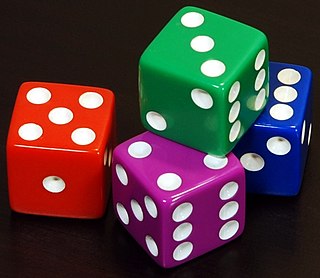
Dice are small, throwable objects with marked sides that can rest in multiple positions. They are used for generating random values, commonly as part of tabletop games, including dice games, board games, role-playing games, and games of chance.

Parcheesi is a brand-name American adaptation of the Indian cross and circle board game Pachisi, published by Parker Brothers and Winning Moves Games USA.

Yahtzee is a dice game made by Milton Bradley. It was first marketed under the name of Yahtzee by game entrepreneur Edwin S. Lowe in 1956. The game is a development of earlier dice games such as Poker Dice, Yacht and Generala. It is also similar to Yatzy, which is popular in Scandinavia.
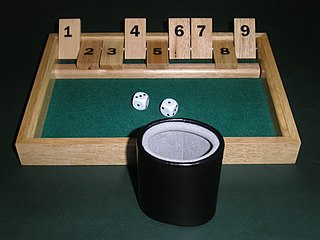
Shut the box is a game of dice for one or more players, commonly played in a group of two to four for stakes. Traditionally, a counting box is used with tiles numbered 1 to 9 where each can be covered with a hinged or sliding mechanism, though the game can be played with only a pair of dice, pen, and paper. Variations exist where the box has 10 or 12 tiles. In 2018 the game had a renaissance in Liverpool, England, when it became the house game at Hobo Kiosk pub on the Baltic Triangle. It was popularized by DJ duo Coffee and Turntables and became the most played board game in Merseyside for 4 years in a row.

Pig is a simple dice game first described in print by John Scarne in 1945. Players take turns to roll a single dice as many times as they wish, adding all roll results to a running total, but losing their gained score for the turn if they roll a 1.
Liar's dice is a class of dice games for two or more players requiring the ability to deceive and to detect an opponent's deception. In "single hand" liar's dice games, each player has a set of dice, all players roll once, and the bids relate to the dice each player can see plus all the concealed dice. In "common hand" games, there is one set of dice which is passed from player to player. The bids relate to the dice as they are in front of the bidder after selected dice have been re-rolled. Originating during the 15th century, the game subsequently spread to Latin American and European countries. In 1993, a variant, Call My Bluff, won the Spiel des Jahres.

Cee-lo is a gambling game played with three six-sided dice. There is not one standard set of rules, but there are some constants that hold true to all sets of rules. The name comes from the Chinese Sì-Wŭ-Liù (四五六), meaning "four-five-six". In America it is also called "See-Low," "Four-Five-Six," "The Three Dice Game," "Roll-off!," and by several alternative spellings, as well as simply "Dice." In China it is also called "Sān Liù Bàozi" (三六豹子), or "Three-Six Leopards". In Japan, it is known as "Chinchiro" (チンチロ) or "Chinchirorin" (チンチロリン).

Dudo, also known as Cacho, Pico, Perudo, Liar's Dice, Cachito or Dadinho is a popular dice game played in South America. It is a more specific version of a family of games collectively called Liar's Dice, which has many forms and variants. This game can be played by two or more players and consists of guessing how many dice, placed under cups, there are on the table showing a certain number. The player who loses a round loses one of their dice. The last player to still have dice is the winner.
Dice chess can refer to a number of chess variants in which dice are used to alter gameplay; specifically that the moves available to each player are determined by rolling a pair of ordinary six-sided dice. There are many different variations of this form of dice chess. One of them is described here.
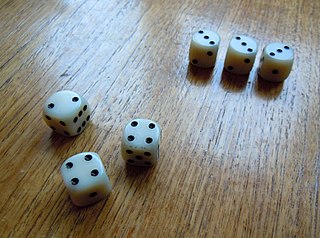
Dice 10,000 also Greed, Dix Mille, 5-Dice is the name of a family dice game played with 6 dice, it is similar or identical to the commercialized Farkle. It also goes by other names, including Zilch, Zilchers, Foo, Boxcar, Bogus, Lewis' Dice and Crap Out.
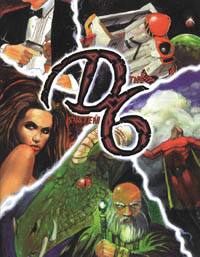
The D6 System is a role-playing game system published by West End Games (WEG) and licensees. While the system is primarily intended for pen-and-paper role-playing games, variations of the system have also been used in live action role-playing games and miniature battle games. The system is named after the 6-sided die, which is used in every roll required by the system.
Mexico is an elimination-style dice game, in which several players agree to play a set number of rounds. After each round, one player is eliminated. When all players but one have been eliminated, the remaining player wins the game. Owing to its extremely simple play-structure, it is generally pursued as a method of gambling, whereby the final remaining player wins the amount of money wagered by each person who was eliminated in earlier rounds. A variant of the drinking game liar's dice known as Mexican or Mia uses similar dice rolls, but has very different game mechanics.
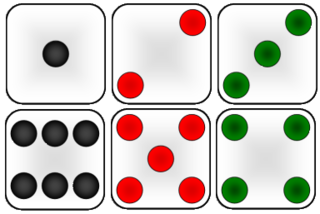
Kismet is a commercial dice game introduced in 1964. The game's name is the Turkish word for "fate". E. William DeLaittre holds the trademark on the game, which was originally published by Lakeside Games, and which is currently produced by Endless Games. Marketed as "The Modern Game of Yacht", the game play is similar to Yacht and Yahtzee, with a few variations. A primary distinction is that in Kismet, the sides of the dice have different colored pips.

Poker dice are dice which, instead of having number pips, have representations of playing cards upon them. Poker dice have six sides, one each of an Ace, King, Queen, Jack, 10, and 9, and are used to form a poker hand.

Swipe is a proprietary dice game for two to six players made by Fundex Games in 2004. The object of the game is to win chips through the rolling of special dice that can be used to win chips or dice from the center (kitty) or from other players.
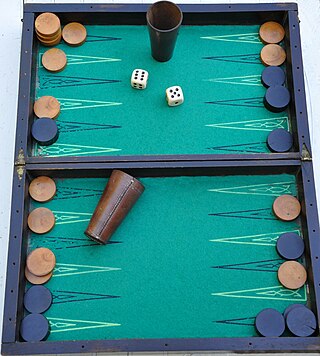
Jacquet is a tables game, played on the same type of board as Backgammon, that was once very popular in France and several other parts of Europe. It probably emerged around 1800, but is attested by 1827. In the 20th century it replaced the classic French backgammon equivalent — the game of Trictrac — until Jacquet itself was superseded by Anglo-American games in the 1960s.
A number of related games under the Yahtzee brand have been produced. They all commonly use dice as the primary tool for game play, but all differ generally. As Yahtzee itself has been sold since 1954, the variants released over the years are more recent in comparison, with the oldest one, Triple Yahtzee, developed in 1972, eighteen years after the introduction of the parent game.
Sho is a traditional race game in Tibet, still common today. Its name is simply the Tibetan word for "dice". It is traditionally played for money and by men, with two to four players - three being the most common. With four players, the usual variant is to play as two teams of two, with the partners sitting opposite each other.

Cacho Alalay is a popular dice game from Latin America. It is similar to Yahtzee/Yatzy. The purpose of the game is to roll five dice and score points from their combinations. The dice are rolled from a leather cup.